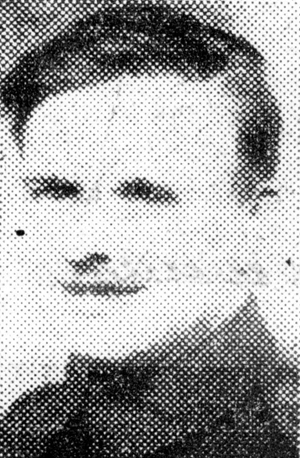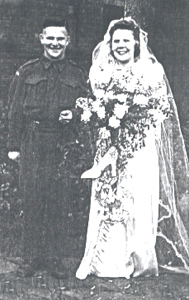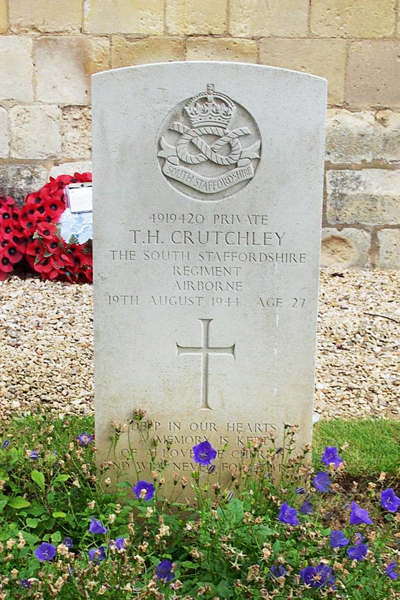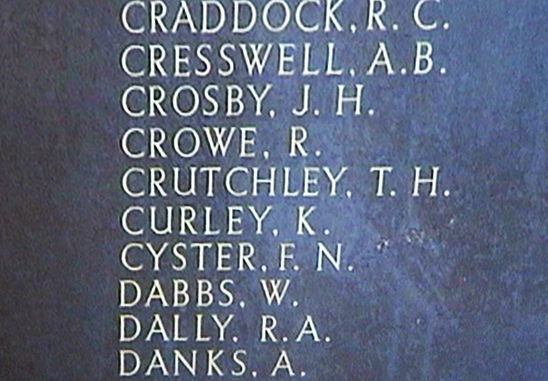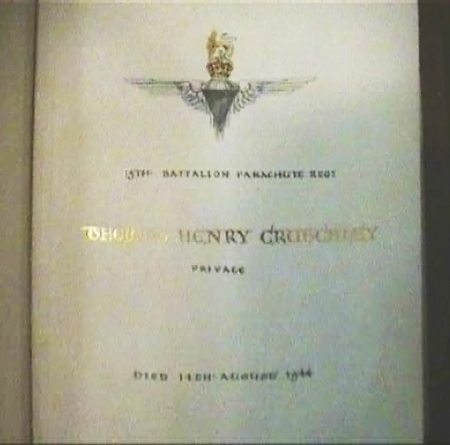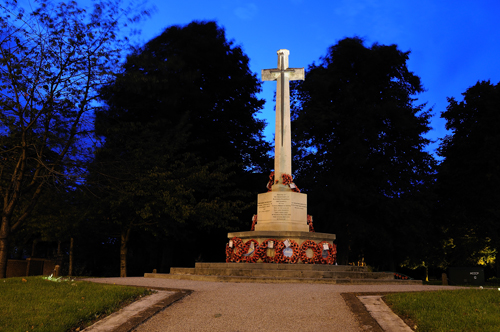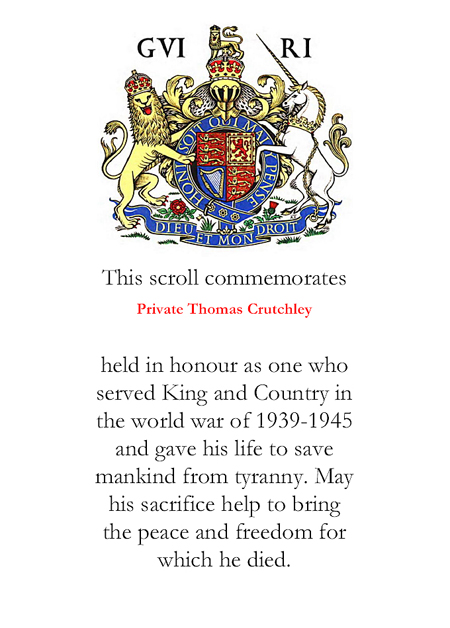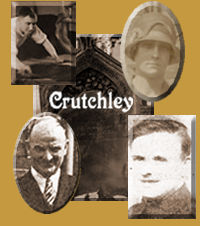
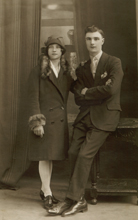
Black Country Genealogy
THE LIFE OF THOMAS HENRY CRUTCHLEY - A SOLDIER'S STORY |
Thomas Henry Crutchley, 1944. |
The story of Thomas Henry Crutchley is mirrored a million times over by those who fell victim to the brutality of the Second World War. His life and fate are above all typical examples of the lives and deaths of millions of people from the period, but his story is no less tragic for it. Thomas Henry's story highlights the manner in which the rank and file of the 1940's world became involved in a bloody war, and paid the ultimate price to ensure our freedom. Thomas Henry Crutchley was born in Bloxwich in 1917, the son of Thomas Henry and Clara Crutchley. His was a large family, but not unusually so for the times. He was blessed with four brothers and four sisters. Thomas Henry's father was a locksmith, apparently of some repute within his local Black Country community. Within and without the Black Country the town of Willenhall was rightly famous for lock making, however, the trade itself was conducted as a cottage industry in many parts of the region. Like many others, Thomas Henry senior operated his business from a small workshop at the bottom of the garden to the rear of his home at 110 Field Road, Bloxwich. According to the recollections of his grandson, Norman Crutchley, Thomas Henry senior was a man of short stature. Norman recalls the workshop where Thomas Henry senior worked, as being crammed with tools and having numerous key blanks hanging from its roof. Little is known or remembered about Thomas Henry junior's early life before the events of the Second World War caught up with him, and swept him far from his home town of Bloxwich. However, surviving employment records do show he worked making tiles at the nearby Essington Tileries. During the war Thomas Henry found romance and married Lillie Annie Herriott from Winson Green in Birmingham on the 9th September 1943. By the time of their wedding, which took place at the height of the war, Thomas Henry was already serving in the army, as the uniform in his wedding photograph testifies. Although he was on leave at home for his wedding, Thomas's fate was now inextricably linked with the monumental events which were to mark the beginning of the end of the Second World War.
The wedding of Thomas Henry Crutchley and Lily Annie Herriott, 9th September 1943. On the day that Thomas and Lily Annie married, the date of the launch the long awaited operation to liberate Europe was fast approaching, and the Allies were amassing a huge invasion force in sothern England. The task of the men waiting to cross the English Channel was create a bridgehead in France and then push the Germans back northwards towards the River Rhine. Across the whole of the South of England, vast numbers of troops and equipment were made ready for the brutal and costly offensive which was soon to follow. Thousands of ships were placed on standby, their task to carry wave upon wave of Allied troops and their armour across the English Channel to France. Aircraft, gliders and their crews were mustered ready to undertake aerial operations from airfields across England. Millions of soldiers just like Thomas Henry waited in dire anticipation to learn what their part in Operation Overlord would be, not knowing when or where their battle would commence, but in the certain knowledge that soon it would. Whilst the preparations for D-Day were being made, Thomas Henry Crutchley was serving in the in the South Staffordshire Regiment. At this time, he was attached to the 13th (2/4th Bn. The Lancashire Regt.) Bn., Parachute Regiment, A.A.C. Thomas's battalion was formed in May 1943, mostly from volunteers like Thomas but their training was intense. The recruits took on a twelve-week parachute training course at No. 1 Parachute Training School, located at RAF Ringway. Thomas Henry would have made a balloon jump and later five jumps from aircraft, those who were successful received the coveted maroon coloured beret. The training these men faced needed to be rigorous because the destiny of most airborne units was to face the enemy at close ranges and outnumbered. On the 6th June 1944 after delays due to bad weather, Operation Overlord, the decisive battle to liberate France and ultimately the whole of occupied Europe began. The evening before the first troops landed on the beaches, large numbers of airborne troops like Thomas Henry paved the way for the greatest invasion force the world has ever seen. On the morning of D-Day, after weeks of intense aerial bombardment and heavy naval shelling of the German positions along the French coast, the first waves of Allied troops went ashore on the beaches of Normandy. In the weeks that followed the initial D-Day landings, Allied progress in France was slower than anticipated, a result of powerful German opposition and difficult terrain. Consequently the Allies had to fight for every single inch of the ground they liberated, but slowly they drove the occupiers backwards and ultimately out of France. It is not known exactly when Thomas Henry Crutchley entered the battle, but most likely it was some time in late June or possibly the early days of July 1944. Records show that at the time of his death, Thomas had been fighting in the battle to liberate France for about a month, which indicates that he probably entered the battle in early July 1944. This would suggest that he may have joined his battalion as a reinforcement with the waves of men who crossed to France in the days that followed D-Day. As the invasion forced pushed on in France, German resistance lingered in many areas. Hence on August 17th Operation Paddle was launched. This action was an attempt to hasten the liberation of France, and ultimately the remainder of Europe. The plan was for the First British Corps to move towards the East of the River Seine, in order to liberate the Pays d'Auge. They were also tasked with pursuing to destruction a desperately fleeing German Army. This operation, which was to be Thomas Henry's last, was planned to end on August 30th with the liberation of the Normandy city of Honfleur. Thomas Henry Crutchley entered the battler and was killed in action on August 19th, in or near the village of Putot en Auge. Records of the battle show that Thomas was killed by enemy heavy machine gun fire, whilst his unit was storming German positions on a hill referred to as 'Hill 13', which overlooks village. For a month Thomas had experienced the full horrors of Normandy in 1944, before he himself finally fell victim to those very same horrors. His fate was shared by several of his comrades from the same regiment, who also died on the August 19th during the same action. Thomas Henry Crutchley lies buried with his comrades in the Commonwealth War Graves section of the peaceful Churchyard at Putot en Auge.
The grave of Thomas Henry Crutchley Putot en Auge, France. August 19th 2004 Marked the 60th anniversary of the death of Thomas Henry Crutchley in the battle to liberate Putot en Auge. Thomas's sacrifice was commemorated by my family in both Putot en Auge and Bloxwich. To see how we commemorated Thomas Henry Crutchley, please click here.
Walsall Town Roll Of Honour The Town Hall, Walsall. The year 2005 marked the 60th anniversary of the end of the Second World War. On Sunday 13th November 2005, the annual Service of Remembrance was held at the cenotaph in Bloxwich, Thomas Henry Crutchley's home town. His sacrifice was commemorated by the placing of a poppy cross. To see photographs of the service, cenotaph and cross, click here.
The memorial book All Saint's Parish Church, Bloxwich. Each year at eleven o'clock on Remembrance Sunday the sacrifices made by Thomas Henry Crutchley, and the other citizens of Bloxwich killed in conflict are remembered. To see how Remembrance Sunday was commemorated in 2008, click here. If you would like to watch a complete video of the Bloxwich service of remembrance held in 2002, click here. August 19th 2009 marked the 65th anniversary of the death of Thomas Henry Crutchley. The image below shows the cenotaph in his home town of Bloxwich on this important day. Our remembrance of the courage of Thomas Henry Crutchley continues each year on 11th November, even during the corona virus pandemic of 2020.
Bloxwich Cenotaph, 19th August 2009, the 65th Anniversary Of The Death Of Thomas Henry Crutchley. Acknowledgments Thanks must be extended to Norman Crutchley, for the wealth of information that he has provided during the compilation of this history. Thanks also to Isabelle Vagnarelli of La Bibliotheque Electronic de Lisieux for the invaluable photographs of Thomas Henry Crutchley's grave, and other information that she provided. To download the full story of the Battle for Putot en Auge, click here (191 kb) and choose 'Save target as....' to download an Adobe Acrobat file. For more information about the 13th Battalion, the Parachute Regiment, click here.
Private Thomas Crutchley Roll of Honour.
|
